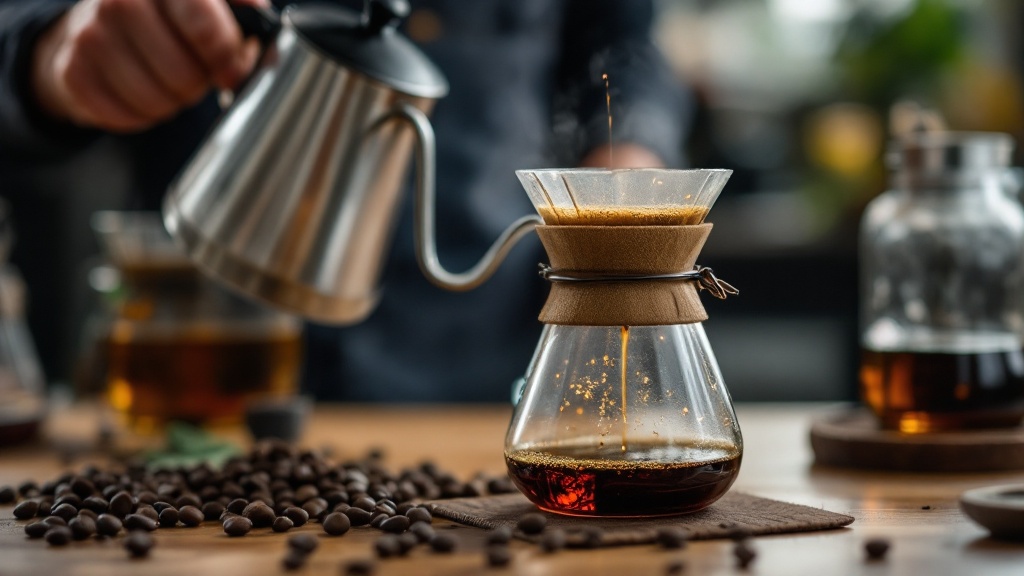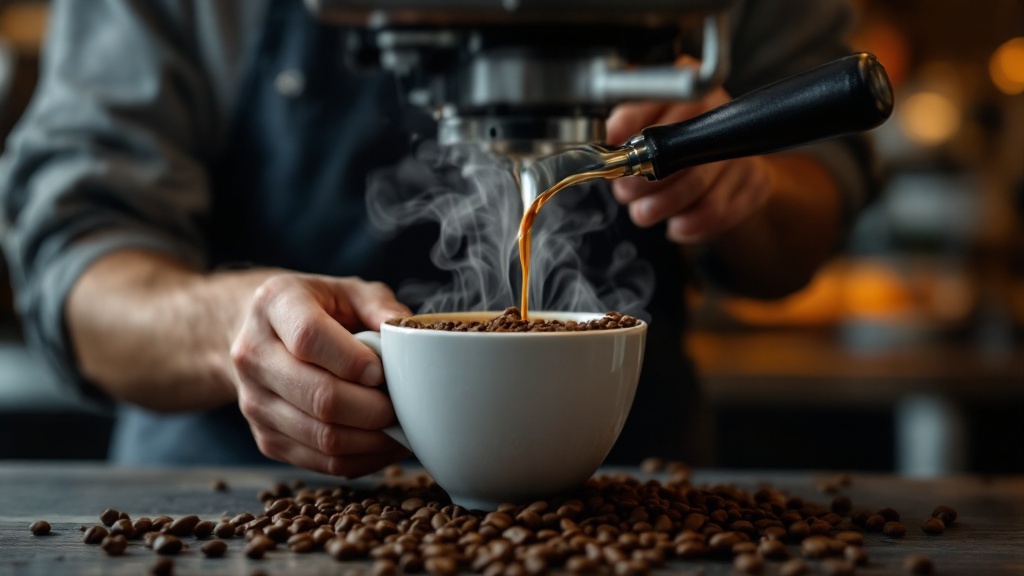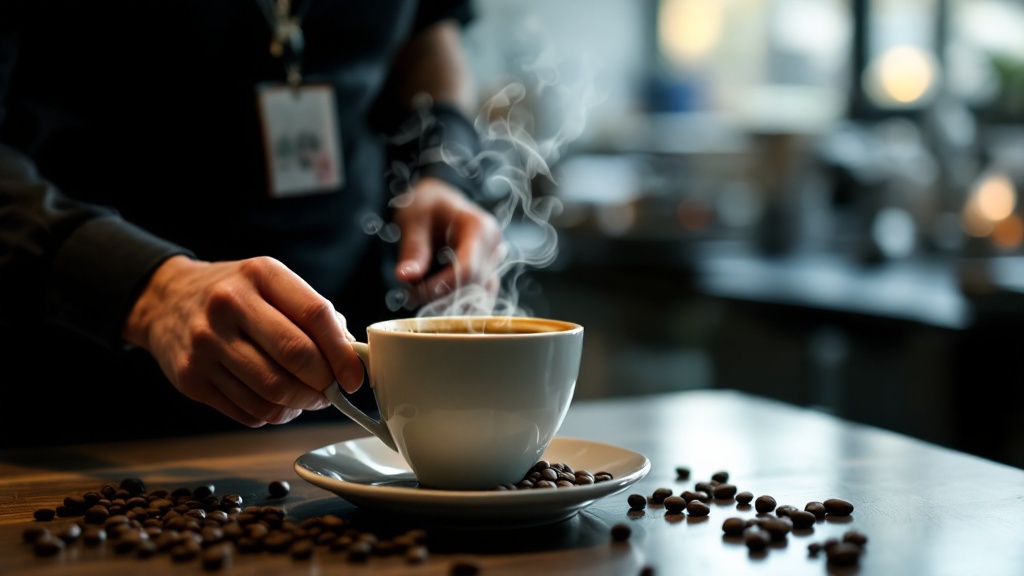Unlock the secrets to brewing the perfect cup of coffee, no matter your skill level! This comprehensive guide dives deep into various coffee brewing methods, from classic French press to the art of espresso, empowering you to craft exceptional coffee at home. Learn to master the variables that impact flavor and unlock your inner barista with our expert tips and techniques. Get ready to elevate your coffee game!
-
Unlock Your Inner Barista: Mastering the Art of Coffee Brewing Methods
-
Immerse Yourself in Flavor: Exploring Diverse Coffee Brewing Methods
-
Essential Tools and Techniques for Perfect Coffee Brewing Methods
-
Mastering the Variables: Best Practices for Unforgettable Coffee
-
Troubleshooting Your Brew: Common Challenges and Solutions in Coffee Brewing Methods
-
The Rewards of Brewing: Benefits and Considerations of Coffee Brewing Methods
-
Expert Advice: Tips and Tricks for Elevate Your Coffee Brewing
-
Beyond the Brew: Exploring Related Coffee Topics and Applications
-
Conclusion
Unlock Your Inner Barista: Mastering the Art of Coffee Brewing Methods

Coffee brewing is the magical process of transforming humble beans into a rich, aromatic elixir. It’s all about extracting the perfect balance of flavors – acidity, bitterness, sweetness, and body – from your grounds using water. This delicate dance hinges on several crucial factors: grind size, water temperature, brewing time, and the all-important coffee-to-water ratio. Different brewing methods, from the classic drip to the innovative AeroPress, offer unique approaches to achieve this balance, each yielding distinct flavor profiles. Understanding these variables is key to unlocking your coffee’s full potential and brewing the perfect cup, every time. The optimal extraction rate, as noted by James Hoffmann, lies between 18-22% of the coffee’s mass, a sweet spot to aim for.
Optimizing Extraction Yield
Achieving optimal coffee extraction involves precise control over several key parameters, primarily influencing the rate of soluble solids transferred from the coffee grounds into the brewed beverage. The target extraction yield, as widely accepted within the specialty coffee community, falls within the 18-22% range of the coffee’s total mass. Falling below this range results in under-extraction, characterized by weak, sour, and under-bodied brews. Conversely, exceeding this range leads to over-extraction, producing bitter, astringent, and potentially harsh flavors. The precise optimal range may vary slightly based on factors such as bean origin, roast level, and personal preference, however, remaining within the 18-22% range provides a reliable baseline for quality brewing.
“Mastering coffee brewing is a science of precision: grind, temperature, time, and ratio converge to unlock 18-22% extraction–the sweet spot of flavor.”
– James Hoffmann, Coffee Expert and Author
- Grind size significantly impacts extraction; finer grinds yield higher extraction, while coarser grinds yield lower extraction.
- Water temperature plays a crucial role: temperatures between 195-205°F (90-96°C) are generally ideal for optimal extraction.
- Brew time directly influences extraction; longer brew times generally lead to higher extraction yields.
- Coffee-to-water ratio affects concentration and, consequently, the perceived extraction; a higher coffee-to-water ratio typically results in a higher extraction percentage, assuming other factors remain constant.
- Different brewing methods inherently influence extraction yield due to variations in water flow rate, contact time, and temperature consistency.
| Key Aspect | Grind Size | Water Temp | Brew Time |
|---|---|---|---|
| Extraction Impact | Finer = Higher extraction | 195-205°F (90-96°C) | Longer = Higher extraction |
| Optimal Range | Varies by method | 195-205°F (90-96°C) | Varies by method |
| Extraction Yield | 18-22% of coffee mass | 18-22% of coffee mass | 18-22% of coffee mass |
Immerse Yourself in Flavor: Exploring Diverse Coffee Brewing Methods

The world of coffee brewing is incredibly diverse, offering various approaches to extract those delicious compounds. Immersion methods, like using a French press or AeroPress, fully submerge the grounds in water, resulting in a rich, full-bodied brew. In contrast, percolation methods, such as drip coffee and pour-over, gently pass water through the grounds, creating a cleaner, more nuanced cup. Espresso, on the other hand, utilizes high pressure to extract a concentrated shot of intense flavor. Then there’s cold brew, a gentler giant where coarsely ground coffee steeps in cold water for hours, yielding a smooth, low-acidity brew ideal for those who prefer a less intense caffeine kick. Finally, whether you choose single-origin coffees to showcase unique terroir or blends for balanced complexity depends on your palate’s preference.
French Press Extraction Dynamics
The French press, a quintessential immersion brewing device, relies on a specific process of total immersion and subsequent separation to achieve its characteristic full-bodied extraction. The brewing process begins with a precise coffee-to-water ratio, typically ranging from 1:15 to 1:18 by weight, depending on desired strength and bean characteristics. Coarsely ground coffee, ideally exhibiting a consistency similar to coarse sea salt, is added to the carafe. Water, heated to a temperature between 195-205°F (90-96°C), is then gently poured over the grounds, ensuring even saturation. A crucial aspect of this process is the blooming phase: a brief period (approximately 30-45 seconds) where the grounds are allowed to degas and absorb water before the remaining water is added. This step is essential for uniform extraction and minimizes the risk of channeling, where water preferentially flows through certain parts of the grounds, resulting in uneven flavor profiles.
“The method you choose to brew coffee shapes its soul–immersion for richness, percolation for clarity, and pressure for intensity.”
– James Hoffmann, World Barista Champion and Coffee Expert
- Steep time significantly impacts extraction; longer steeps (4-6 minutes) yield a bolder flavor, while shorter steeps result in a lighter, brighter cup.
- Metal French presses offer superior heat retention compared to glass, influencing brewing temperature and extraction.
- Proper grinding is crucial; too fine a grind leads to over-extraction and bitterness, while too coarse results in under-extraction and weakness.
- The “plunging” action should be slow and steady to prevent sediment from entering the final brew.
- Coffee bean origin and roast level directly influence the ideal coffee-to-water ratio and brewing time.
- Experiment with different water sources; mineral content affects taste and extraction.
Essential Tools and Techniques for Perfect Coffee Brewing Methods

Crafting the perfect cup requires the right tools and a bit of know-how. A burr grinder is essential for consistent grind size, a gooseneck kettle provides precise water pouring for pour-over methods, and a scale ensures accurate coffee-to-water ratios. A timer helps control brew time, and of course, you’ll need your chosen brewing device – a French press, Chemex, or espresso machine. Beyond the equipment, high-quality, freshly roasted beans and filtered water (around 150 ppm mineral content is optimal) are paramount. Mastering grind size adjustment, precise water temperature control (around 195-205°F for hot brewing), and consistent pouring techniques will elevate your brewing game.
Grind Size Distribution Analysis
Achieving optimal coffee extraction relies heavily on a precise grind size distribution. Uniformity, measured by particle size distribution (PSD), directly impacts the rate of water percolation through the coffee bed. A burr grinder, unlike blade grinders which produce a highly inconsistent particle size, is crucial for achieving a narrow PSD. Ideally, a target range of 300-400 microns with minimal fines (particles under 100 microns) and oversized particles (above 500 microns) should be aimed for. Fines over-extract, leading to bitterness and astringency, while oversized particles under-extract, resulting in weak, sour coffee. The specific optimal grind size varies depending on brewing method; espresso requires a significantly finer grind than pour-over. For example, using an espresso machine, a grind size of approximately 200-250 microns is often targeted. In contrast, a pour-over method might utilize a grind size of 350-450 microns, depending on the bean’s density and the brewer’s specific parameters. Regular calibration and adjustment of your burr grinder are essential to maintain consistent output, especially with different bean densities or after prolonged use. Regular cleaning also prevents the accumulation of fines, which affect overall grind size distribution and hinder extraction. Tools such as a grind size analyzer (e.g., using image analysis software) or even a simple visual inspection of the grounds after grinding can help assess the consistency of the grind distribution.
- Different brew methods demand significantly different grind sizes; espresso requires a much finer grind (200-250 microns) than pour-over (350-450 microns).
- Fines (<100 microns) cause over-extraction, leading to bitterness and astringency, while oversized particles (>500 microns) under-extract, resulting in sourness.
- Bean density directly influences the ideal grind size; denser beans generally require a slightly coarser grind.
- Regular burr grinder calibration is crucial for maintaining consistent particle size distribution, especially after prolonged use or changes in bean type.
- Grind size analyzers, using image analysis, offer precise measurements of particle size distribution, aiding in optimization.
- Clean your grinder regularly to prevent the build-up of fines, which can negatively impact the overall grind size distribution and extraction.
Mastering the Variables: Best Practices for Unforgettable Coffee

Achieving consistent, delicious coffee involves mastering a few key techniques. The grind size needs to be perfectly matched to your brewing method – coarse for French press, fine for espresso. Always use filtered water to eliminate any off-flavors. A good starting point is a 1:16 coffee-to-water ratio, but feel free to experiment to find your perfect balance. The “bloom,” a pre-wetting of the grounds in pour-over methods, is crucial for releasing CO2 and enhancing extraction. Maintaining a consistent pour speed, water temperature, and even agitation are key to unlocking your coffee’s full potential, and remember, regular cleaning prevents residue from impacting the taste of your precious brew.
Optimal Coffee Extraction Ratios
Achieving optimal coffee extraction requires a precise understanding of the coffee-to-water ratio (CWR). While a 1:16 ratio serves as a useful starting point, the ideal CWR is highly dependent on several factors, including bean origin, roast level, grind size, and brewing method. A lower CWR (e.g., 1:15) will generally result in a stronger, more concentrated brew with increased bitterness and potentially astringency, due to over-extraction of undesirable compounds. Conversely, a higher CWR (e.g., 1:17 or 1:18) will produce a weaker, less intense brew, potentially leading to under-extraction and a sour, underdeveloped taste profile. The goal is to find the sweet spot where the desirable flavor compounds are fully extracted without over-extracting bitter or astringent components.
- Freshly roasted beans generally require a slightly higher CWR (e.g., 1:17) than older beans.
- Finer grinds necessitate a lower CWR to avoid over-extraction and bitterness.
- Pour-over methods often benefit from a slightly higher CWR (1:16-1:17) compared to espresso (1:2 – 1:3).
- Taste is subjective; experiment within a range (e.g., 1:15-1:18) to find your personal preference.
- Consider using a coffee scale for precise measurements to achieve consistent results.
Troubleshooting Your Brew: Common Challenges and Solutions in Coffee Brewing Methods

Even experienced baristas face occasional brewing hiccups. Over-extraction can lead to a bitter, astringent taste; try using a coarser grind, reducing brew time, or lowering water temperature to solve this. Under-extraction results in a sour, weak brew; simply adjust to a finer grind, extend the brew time, or increase the water temperature. Espresso brewing often encounters channeling (uneven extraction), solved by even distribution and consistent tamping. Clogging in a French press is often fixed by using a coarser grind and avoiding excessive agitation. Inconsistent results are usually eliminated by weighing both your coffee and water, avoiding the inaccuracies of volume measurements.
Espresso Channeling Mitigation
Channeling, a prevalent issue in espresso extraction, manifests as uneven water flow through the coffee puck, leading to inconsistent extraction and a compromised final beverage. This phenomenon is primarily caused by inconsistencies in the coffee bed’s density and structure. Uneven distribution of the ground coffee before tamping results in preferential pathways for water, allowing it to bypass certain areas of the puck, leaving some grounds under-extracted (sour) and others over-extracted (bitter). The resulting espresso will lack balance and exhibit off-flavors. Effective mitigation involves a meticulous approach to pre-infusion and tamping. Pre-infusion, a short period of low-pressure water saturation before the full extraction, helps to saturate the coffee grounds evenly, reducing the likelihood of channeling. However, pre-infusion settings vary by machine; the optimal duration and pressure often require experimentation tailored to the specific espresso machine model and grind size.
- Use a distribution tool (WDT tool) to ensure even coffee bed distribution before tamping, breaking up clumps and creating a uniform surface.
- Employ a consistent tamping pressure (typically 30-40 lbs) using a calibrated tamper to achieve uniform puck density.
- Adjust grinder settings to achieve the ideal particle size distribution for your specific beans and machine, minimizing fines and boulders that contribute to channeling.
- Experiment with pre-infusion settings (time and pressure) to find the optimal parameters for your equipment and grind size; start with a shorter pre-infusion time and gradually increase it.
- Consider using a finer grind size if channeling persists, as this can help to improve the overall consistency of the puck.
The Rewards of Brewing: Benefits and Considerations of Coffee Brewing Methods

The journey of mastering coffee brewing methods is incredibly rewarding. You gain complete control over your flavor profiles, developing a deeper appreciation for the complexity of coffee. Brewing at home can also be more cost-effective than frequent café visits. However, it does involve an initial investment in equipment and a learning curve to master the techniques. Using fresh, high-quality beans and ensuring optimal water quality are crucial to success. The effort, however, is more than worth it when you experience that first perfect, personalized cup.
Water Chemistry’s Impact
The precise chemical composition of brewing water significantly impacts the final cup of coffee. Total dissolved solids (TDS), measured in parts per million (ppm), represent the concentration of minerals like calcium, magnesium, bicarbonates, and sulfates. Ideally, brewing water should have a TDS between 75-150 ppm. Water with excessively low TDS can result in a flat, weak, and under-extracted brew, lacking body and flavor complexity. Conversely, water with high TDS, particularly high levels of bicarbonates, can lead to a bitter, astringent cup due to the formation of insoluble compounds that negatively affect the extraction process. Different brewing methods may have slightly different ideal TDS ranges; espresso, for example, often benefits from a higher TDS due to the short extraction time.
- Calcium and magnesium contribute to water hardness, influencing coffee’s body and mouthfeel; low levels can lead to a thin brew.
- Bicarbonates can cause a bitter taste if present in high concentrations, reacting with coffee compounds during brewing.
- Sulfates impact coffee’s brightness and acidity; higher sulfate levels can enhance the perceived sweetness.
- Chlorine and other chemicals in tap water can negatively impact flavor; filtering is often recommended.
- The ideal TDS range can vary based on coffee bean origin and roast level, influencing extraction efficiency.
Expert Advice: Tips and Tricks for Elevate Your Coffee Brewing

To truly elevate your coffee game, remember these expert tips: always grind your beans immediately before brewing to maximize freshness. Embrace experimentation – adjust variables like grind size and ratio to discover your perfect cup. Invest in a scale for precise measurements and improve consistency. Start with simpler immersion methods like the French press before tackling more advanced techniques like pour-over or espresso. And finally, learn from the masters! Explore online resources, tutorials, and courses to continuously improve your brewing skills.
Brew Ratio Optimization
Achieving optimal extraction in coffee brewing hinges critically on the brew ratio, defined as the ratio of coffee grounds to water. A commonly recommended starting point is a 1:15 ratio (e.g., 1 gram of coffee to 15 grams of water), but this serves only as a baseline. Factors such as bean origin, roast level, and desired flavor profile significantly influence the ideal ratio. Lighter roasts, generally possessing more nuanced acidity and delicate aromatics, often benefit from a slightly lower ratio (e.g., 1:14 or even 1:13), allowing for a brighter, more expressive cup. Conversely, darker roasts, with their more robust and bitter characteristics, may necessitate a slightly higher ratio (e.g., 1:16 or 1:17) to avoid over-extraction and excessive bitterness. Precise measurement using a calibrated digital scale is paramount for consistent results.
- Water temperature also impacts extraction; aim for 195-205°F (90-96°C) for optimal results.
- Grind size is crucial; finer grinds extract faster, requiring potentially lower ratios.
- Experiment in small increments (e.g., 0.5g of coffee at a time) to avoid drastic changes in flavor.
- Taste your brew at each ratio adjustment to determine your preference; note the changes in acidity, body, and bitterness.
- Consider using a brew ratio calculator for convenience and to track your experiments.
Beyond the Brew: Exploring Related Coffee Topics and Applications

The world of coffee extends far beyond the brewing process. Understanding coffee roasting and the impact of different roast levels (light, medium, dark) on flavor is essential. Latte art, the art of milk steaming and pouring designs, adds a visually stunning element to espresso-based drinks. Sustainability in coffee sourcing, composting coffee grounds, and minimizing waste are crucial considerations. Delving into coffee chemistry, exploring compounds like caffeine and chlorogenic acids, offers fascinating insights into flavor and health. For the truly adventurous, home espresso brewing and mastering its nuances presents the ultimate challenge, requiring precise control and equipment maintenance.
Espresso Extraction Optimization
Achieving optimal espresso extraction requires precise control over several key parameters. The most crucial is the extraction yield, typically expressed as a percentage of the dry coffee mass extracted into the resulting espresso. A target range of 18-22% is generally sought, although this can vary depending on the specific coffee bean characteristics and desired flavor profile. Extraction yield is heavily influenced by grind size, dose (coffee mass), and brew time. Too fine a grind will lead to over-extraction, resulting in bitter and astringent flavors, while too coarse a grind will cause under-extraction, yielding sour and underdeveloped notes. Brew time, usually between 25-30 seconds, directly impacts the extraction yield; longer brew times tend to increase yield. Precise control of these variables is crucial for consistent results. For example, a common approach for optimizing extraction is using a calibrated scale to measure the coffee dose and the mass of the extracted espresso, allowing for calculation of the extraction yield and iterative adjustments to the grind size to achieve the desired range.
Conclusion

So, you’ve journeyed through the diverse world of coffee brewing, discovering the crucial interplay of grind size, water temperature, brew time, and coffee-to-water ratio. Remember, mastering these variables, regardless of your chosen method – from the immersive French press to the pressurized precision of espresso – is the key to unlocking your coffee’s full potential. Embrace experimentation; each method offers a unique flavor profile, allowing you to tailor your brew to your personal preference. The optimal extraction rate (18-22%) acts as your guiding star in this delicious quest.
Now, armed with this knowledge, it’s time to elevate your coffee game. Start by selecting a brewing method that excites you – perhaps a simple pour-over or a challenge like mastering espresso. Experiment with different beans, grind sizes, and water temperatures to discover your perfect cup. Keep detailed notes of your brewing process – it’s the best way to track your progress and refine your technique.
Don’t just brew coffee; *craft* your coffee experience. The journey to the perfect cup is ongoing – embrace the learning, the experimentation, and the sheer joy of unlocking the full aromatic potential within each bean. What will you brew today?
Optimal Extraction Yield
Achieving the optimal extraction yield is paramount for a superior cup of coffee. This range, generally accepted as 18-22%, represents the percentage of soluble coffee solids extracted from the grounds during brewing. Extraction below this range results in an under-extracted brew, characterized by sourness, weak body, and a lack of sweetness. Conversely, over-extraction (above 22%) produces a bitter, astringent, and potentially burnt flavor profile. Several factors influence extraction yield, primarily grind size, water temperature, and brew time. Finer grinds, hotter water, and longer brew times increase extraction, whereas coarser grinds, cooler water, and shorter brew times decrease it.
- Extraction yield is significantly impacted by coffee bean type and roast level; darker roasts generally extract more readily.
- Using a refractometer provides precise measurement of extraction percentage, enabling fine-tuning of brewing parameters.
- Water quality plays a crucial role; mineral content can influence both extraction and flavor.
- Different brew methods inherently lead to varying extraction yields; espresso typically boasts a higher percentage than pour over.
- Aiming for the ideal extraction range improves both the drink’s taste and overall coffee enjoyment.
| Key Aspect | Extraction Yield | Grind Size | Brew Time |
|---|---|---|---|
| Optimal Range | 18-22% | Finer increases extraction | Longer increases extraction |
| Under-Extraction | Below 18% | Coarser decreases extraction | Shorter decreases extraction |
| Over-Extraction | Above 22% | Finer increases extraction | Longer increases extraction |
- A lower yield (below 18%) results in a sour, underdeveloped espresso lacking body and sweetness.
- Over-extraction (above 22%) leads to bitterness, astringency, and a burnt flavor, often accompanied by a harsh mouthfeel.
- Water temperature also impacts extraction; hotter water generally extracts more, while cooler water extracts less.
- Proper tamping pressure ensures even water distribution through the coffee puck, crucial for consistent extraction.
- Using a bottomless portafilter allows visual observation of the espresso’s flow, helping to identify channeling or other extraction issues.
- Different coffee beans have varying extraction characteristics; adjust grind size and brew time accordingly for optimal results.

